Teaching English in Second Life
by Jerome Bump
1. One of the books I reviewed earlier in these pages, Myron Tuman’s Word Perfect: Literacy in the Computer Age, seems even more prophetic now than in 1992:
sophisticated multi-media computers -- with only a minimal textual component --have already found their way into tens of millions of American homes [especially for] video games…. Yet too few are willing to consider the radical implications of these changes…for generations upon generations of future children who will grow up with only incidental contact with print culture. As a group, advocates of hypertext,…tend to gloss over the inevitable intellectual and social dislocations (the losses as well as the gains) represented by the radical restructuring, if not the demise, of print literacy. (79-80)
Altough I was obviously one of those "advocates of hypertext," I concluded that “advocates of online literacy may well have to rescue and re-integrate aspects of print literacy."
2. Since then, I have observed the literacy of one of my grandsons. He is now thirteen-years old, two-hundred pounds, and a defensive lineman on his football team. Yet, if given a writing assignment, he cries. On the other hand, he loves video games, especially one that enables him to build different versions of automobiles. For his sake, and for millions of others now, it seems even more urgent that we use video games to salvage aspects of print literacy.
3. At the moment, the most promising is the “sandbox” game: “an online environment in which code or content changes can be tested without affecting the original system(s).” Because they have no single narrative, sandbox video games are “open-ended, nonlinear.” Sandboxes often invite their users to create their own objects as well as their own avatars, and the objects can be bots and scripted actions, as well as buildings, rooms, landscapes, sculptures, paintings, etc. In other words, the users can create their own personal virtual worlds.
4. The sandbox game which has received the most publicity lately is Second Life (hereafter represented as SL). It has even been identified as the fulfillment of Stephenson’s prophecies in Snow Crash. SL certainly has more features than other online sandbox games, and is the only one open to Macs as well as PCs. Clearly the leader in the field, SL's college partners include Columbia, Harvard, Indiana, Minnesota, New York University, Ohio State, Penn State, Stanford, Southern California, Texas, Washington, and the New Medium Consortium, an “international not-for-profit consortium of nearly 200 leading colleges, universities, museums, corporations, and other learning-focused organizations dedicated to the exploration and use of new media and new technologies.” NMC, which is located in Austin, has a highly developed virtual campus in SL.
5. However, in Megan Conklin's "101 Uses for Second Life in the College Classroom" [PDF] English, rhetoric, and composition were conspicuous by their absence. Until recently, English teachers using SL in their courses were few and far between: two of the pioneers are Bryan Carter, Assistant Professor at Central Missouri State, and Sarah Robbins, a PhD Student in Rhetoric and Composition at Ball State University, Muncie IN. Diane Davis, Associate Professor at the University of Texas at Austin, shared her experience using SL in the classroom:
As part of my rhetorics of cyberculture course, students are required to join a virtual community of their choice, get involved, and then write research reports on it. Some of my students chose Second Life, and they loved it. It proved to be a great spot for the sort of semi-ethographic research they're required to do, and they totally enjoyed the environment. One guy was completely addicted by the end of the course. (email 11 July 2006)
In this course, like those of Carter and Robbins, though the students did not write in the SL virtual world itself, they did write about their experiences exploring SL. These courses point us towards one useful area of writing pedagogy employing technology like SL: exploring the cyberculture of a particular virtual community.
6. Other pedagogical projects employing SL, however, might require more financial investment from the host institution. For example, the University of Texas at Austin's Computer Writing and Research Lab (CWRL) developed a research project that hoped to create a separate “architextural” virtual world. The course chosen for the project was a two-semester freshman English course for students entrolled in the Plan II honors program. Unlike a similar previous project using the free, open-source EnCore MOO, this project required a $3,000 investment in a private island in SL. To evaluate the project, the university assigned Dr. Tomoko Traphagan and Michael Mayrath, from Educational Psychology; Kyung Hugh, systems analyst; and Joe Sanchez, from Information Studies.
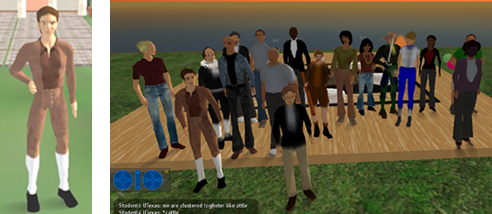
Students made avatars of their role models
7. One of the course assignments focused on social interaction, the most successful feature of SL. The goal was to facilitate reading and writing about leadership, compassion, and the sympathetic imagination (the ability to put oneself in someone else's shoes). Hence, following a writing project on role models, the students redesigned their personal avatars in SL to look like their role models. They were then assigned four different locations on the island to discuss the relationship between leadership and three other topics: compassion, diversity, and history.
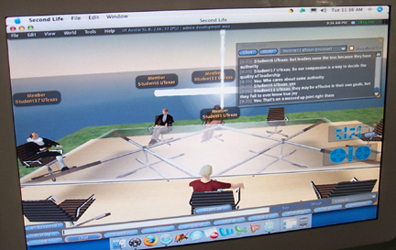
One of four discussion locations on the island
They teleported from one location to the other and saved the text of their discussions which they were then assigned to analyze for the best statements on those topics. One of the primary goals of educational games such as this is to get students "in the flow" and in this case 84% did find it "engaging"; 72% felt that time seemed to fly by during the activity; and 57% found that their attention was "entirely focused on the tasks to be completed." More importantly, 67% agreed that "it was a good learning experience for this class"; 50% thought that their " understanding of the sympathetic imagination increased because of the activity." Focusing on the methods used, 61% thought that "chatting with others while seeing my and others' avatars facilitated discussions better than text-based chats (without visuals)," while only 33% argued that "the activity would have been better if we had done it in classroom in person." Yet only 45% agreed that "chatting in Second Life seemed natural during the activity." The basic problem, as described by one student, is the one that text-based chats have faced since they were invented: " I felt the chat was much too cluttered to really get any cohesive discussion going. I couldn't tell when someone else was attempting to reply to a statement and would often accidentally make comments much after the discussion had moved on because I would be typing while others were already discussing something else."
8. This problem was encountered in the 1980's in the C. W. R. L. when Paul Taylor invented the Daedalus program, Interchange, to conduct class discussion on a local area network. The result then as now was a truly egalitarian, student-centered interchange which supported relatively democratic discussion by all concerned of the goals and methods as well as the subject of the course. However, what was discovered then about the disadvantages of reliance on keyboarding, the loss of voice communication, the slow speed compared to speaking, the loss of coherence, the absence of a controlling instructor, dehumanization, and technostress is still pertinent today [see my 1990 article "Radical Changes"].
9. More relevant today, "is how to teach higher-order thinking and encourage creativity and imagination in the classroom," according to one critic of educational videogames (Edward Miller, senior researcher at the Alliance for Childhood, cited in "Gaming the System," Newsweek April 16, 2007, p. 17). Hence, a more radical and innovative goal of the CWRL SL project was to “re-integrate aspects of print literacy” in that virtual world. A third goal was to create a model of the University of Texas at Austin campus in order "to create a sense of place" as recommended by the Carnegie report.
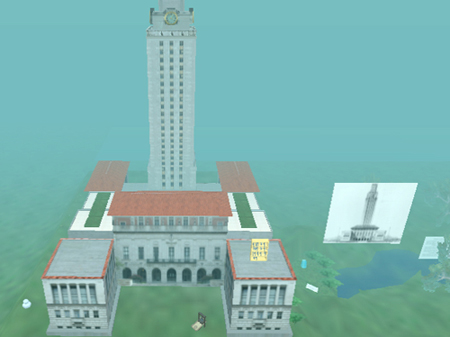
The above screen shot of Second Life depicts the Main Building (aka the Tower) at the University of Texas at Austin
10. During the summer of 2006, Alex Games, of Ed. Psych., designed this building in painstaking detail; he also created a version of the campus creek, with trees, and added a Greek ampitheater for debates.The students’ first major project was to decide how they would rewrite the campus master plan to meet the recommendation of the Carnegie report. Then they were assigned to construct models of the kind of buildings and sculpture they wanted. This required not only creativity and imagination, but also higher-order thinking, including knowledge of geometry. This proved to be extremely difficult for them because of inadequate directions in SL, the complexity of the tasks, and the absence of an expert to show them the way.
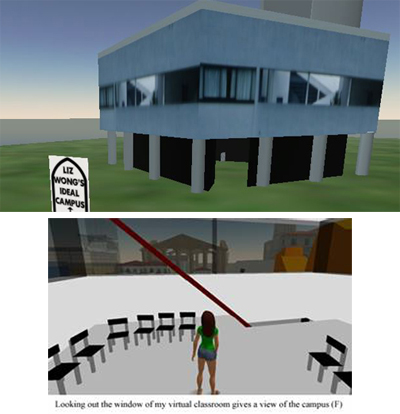
The breakthrough: Elizabeth Wong's building
However, one student, Elizabeth Wong, stayed up late one night and was able to construct a building. The other students gained confidence and went on to produce some extraordinary buildings, such as these three:
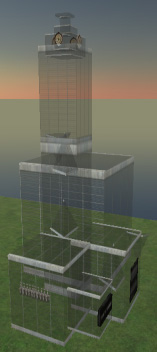
Lawrence Tsai's building
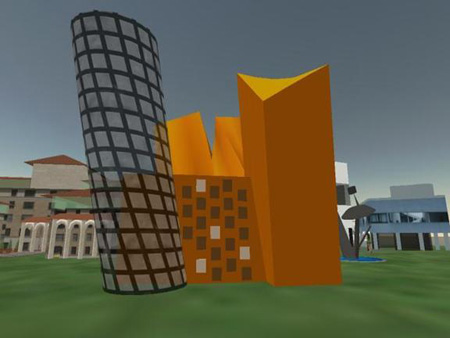
Emily Beck's buildings
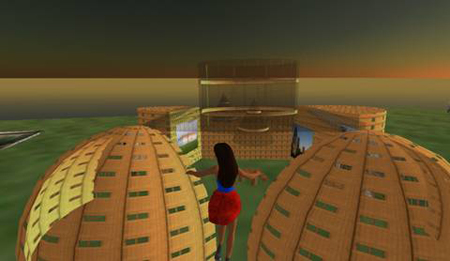
Prianka Singapura's buildings
11. Then their task was to integrate their arguments for their preferred architectural styles with the virtual buildings which exemplified the styles. In other words, they were to somehow fix their arguments onto or into the buildings themselves, thereby communicating in an "architextual" rhetoric, a true 3-D visual-verbal hybrid rhetoric that challenged the limits of their higher-order thinking as well as their imagination. The students discovered that the easiest way to integrate text with architecture was to embed a “webloader” script in an object such as a sign, wall, or other part of a building. When a user discovered and then selected such a sign in the virtual world, an internet browser screen opened with the usual 2-D mix of multimedia and text enlarging the message of the sign. (This invites comparison with how students use hyperlinks in a text-based, 2-D MOO to add pictures and sometimes video to their words.) In the SL virtual campus the most visual but in some ways most difficult way to integrate text and architecture was to embed the text itself in part of a building. Some students cleverly used a note writing script to do this, but the results were often not visible because of the complex SL layers of permissions. Games had provided a third option, bringing in from the main SL site “Thincbooks,” simulations of books, with covers, pages that turned, etc. They thus almost literally resurrected print literacy in the new virtual world. Though the Thincbooks were difficult to master, some students were able to put their entire multimedia projects in the books. In other words, the 2-D mix of words and images they would have put on the internet was now inserted into the pages of these virtual books, which were then put on or near their buildings. The viewer then was able to “turn” the pages of the books and “read” the project and get an overview of it before exploring further. Often the student then provided more embedded texts in the buildings.
12. This process of constructing buildings and embedding texts all took an extraordinary amount of time and I doubt these students would have succeeded if they had not been a special class of very advanced, extremely competitive students. In fact in a survey in the first semester that featured the question, “Do you feel more skilled about technology skills than other students your age,” 93% answered “yes." The survey also reported that 86% felt confident playing virtual world games such as Second Life; 76% liked the use of games in class; and 70% liked playing video games. On the other hand, only 24% “chose to take the course because it used SL.”
13. The project was clearly successful in one respect: 100% of the students agreed that their “awareness of campus architecture has increased because of SL” and over 80% felt that a virtual campus of their university in SL would be “a good recruiting tool”; “good for freshman orientation”; and “good for retaining almuni interest.” 77% also found that their “sense of U.T. as my alma mater increased because of SL.”
14. The relation of SL to writing was more controversial. Our primary goal of integrating visual and verbal rhetoric was achieved in one respect: 71% felt that their “understanding of how to integrate visuals and writing improved because of SL,” though in the second semester the number dropped to 61%. Yet only 56% agreed that “it is a good idea to use SL in a literature and writing course,” and in the second semester the number dropped to 6% (!). Most remarkably, during the first semester only 24% agreed that their “writing skills have improved because of SL,” and during the second no one agreed with the assertion! A second-semester comment revealed the problem: "This program taught us about implementing visual rhetoric, but did now improve our writing." Even though Lester Faigley's Picturing Texts and Little Penguin Handbook were ordered and the first assignment in the course focused on how the new multimedia literacy connects the right and left sides of the brain, apparently the students never accepted the premise that “writing” now includes visual as well as verbal rhetoric.
15. That answer might also reflect the fact that the surveys were administered toward the end of the semesters when they had become burned out on SL. At the end of the first semester, 53% revealed that they did not “really” enjoy the experience of building in SL and 65% were “glad that we are using SL less next semester.”
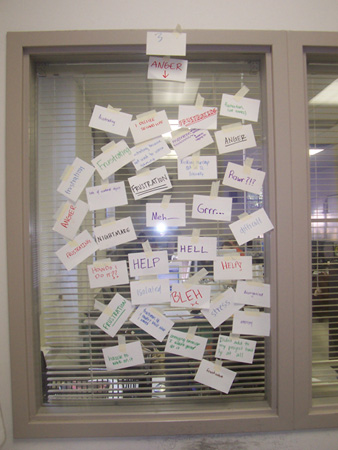
The frustration
When the evaluators came at the end of the semester to do focus groups on SL in class the students expressed their frustration, as we saw when their notes were assembled. There were various causes of this frustration. SL was often down for maintenance. Even when it wasn't, almost every time the students logged onto the program, they had to download and install a new desktop client. One time it was shut down completely for days to deal with a security breach and a change of passwords. Also, with a rapidly growing site with hundreds of thousands of users, permissions and other matters were difficult to resolve at a distance. And, finally, as already stated, without a SL building expert the students were basically on their own.
16. However, the survey results perhaps only make more apparent what I suspect is a basic gulf between two cultures. While the students in the class liked video games and were good at them, and some were adept at the visual arts, all were highly verbal. When they found themselves alone in SL, they found a world of very few words. Indeed, at times it seemed to me that SL was not only basically nonverbal, but even antiverbal. After all, the basic method of learning in the computer world seems to be trial and error, on your own. If you get effective help, it is usually someone showing you, by example, how to do a task, not putting the process into words. Of course it may well be that computers and especially video games attract more nonverbal customers than other activities. And this may be only an extrapolation of a strong American tendency to do rather than to read. For example, how many of us, when given the task of assembling something we have purchased, really take the time first to read the directions carefully? How many of us just skim them or skip them and plunge instead into the assembly process as fast we can, reading directions carefully only as a last resort, when all else fails? Without good clear directions, without someone to show them how to build in SL, that approach did not work well for the students in an English class.
17. And yet, these frustrations and limitations bring us back to the importance as well as the difficulty of our initial claim that "advocates of online literacy may well have to rescue and re-integrate aspects of print literacy." As Richard Lanham argued in 1993, the fact remains that "we can neither preserve the educational system unchanged nor throw out the 'literate' ways of thinking. We have, in some way, to move the humanities from the old to the new operating system" (Lanham, Electronic Word 264).
Jerome Bump, Professor of English, has been teaching at the University of Texas at Austin since 1970. He was the founder and first director of the Computer Writing and Research Lab (1985-1989). For more information see http://www.dwrl.utexas.edu/~bump/.

